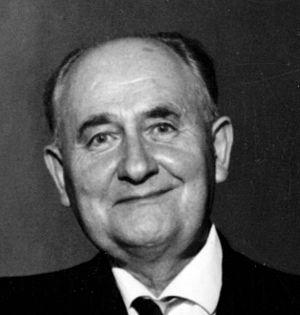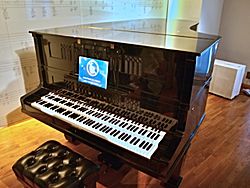Alois Hába facts for kids
Alois Hába (born June 21, 1893 – died November 18, 1973) was a famous Czech composer, music theorist, and teacher. He is known as a key discoverer in modern classical music. Hába was a major composer of microtonal music. This means he used musical scales with smaller steps than usual. He often used quarter-tones, which are half of a half-step. He also explored sixth-tones and twelfth-tones.
Hába wrote many pieces during his career. These include three operas, 16 string quartets, and works for piano, organ, and choir. He also wrote orchestral pieces and songs. To play his unique music, special keyboard and woodwind instruments were built. These instruments could play the tiny quarter-tone steps.
Contents
His Life Story
Alois Hába was born in Vizovice, a small town in Moravian Wallachia. He was one of 10 children. When he was five, people found out he had absolute pitch. This means he could identify any musical note just by hearing it. His family loved music. They often played and sang Wallachian folk songs. They also sang in church and performed folk music.
At school, Alois became very interested in the musical sounds of the Czech language. He studied how pitch, rhythm, and accent worked in speech. In 1908, he went to a teachers' college in Kroměříž. There, he became very interested in Czech national music. He studied the works of Bedřich Smetana. He learned that the European music system was not the only one. He also found that older European music used different scales. This made him want to explore new musical ideas.
After college, he worked as a teacher in Bílovice. It was a small town near the border of what is now Slovakia. He kept studying music on his own. In 1913, he wrote his first compositions. Even then, he did not like to "follow the rules." He kept this independent spirit his whole life. Hába did not like small-town life. In 1914, he moved to Prague. There, he became a student of the composer Vítězslav Novák. In Prague, he studied the music of Claude Debussy and Richard Strauss. He also worked on adding harmonies to Moravian folk music.
Time in Vienna
During World War I, Hába served in the Austrian Army. He was on the Russian and Italian fronts from 1915 to early 1918. Then, he moved to Vienna. He worked in the music department of the Austrian-Hungarian Ministry of War. In Vienna, he quickly became a student of Franz Schreker. Schreker helped Hába develop his more experimental musical ideas.
Around this time, Hába wrote his first quarter-tone piece. It was a Suite with three fugues. He wrote it for two pianos tuned a quarter-tone apart. After the war, Hába stayed in Vienna. He went to concerts organized by Arnold Schönberg. He was especially influenced by Schönberg's "athematic" style. This style means music without a clear main theme. His String Quartet No. 2 was published in 1920. It was his first major quarter-tone work. At this time, he also became lifelong friends with Hanns Eisler. They shared similar musical ideas and political beliefs.
Moving to Berlin
Hába found his first success as a composer in Berlin. He moved there in late 1920 to follow his teacher Schreker. He published his first book about music theory there. It was called Harmonic Essentials of the Quarter-tone System. In 1923, he met Ferruccio Busoni. Busoni was another composer who supported microtonal music, especially sixth-tones. He encouraged Hába to continue his work.
In the same year, Hába tried to start a school for microtonal music. But the Nazis began to gain power in Germany. Hába faced criticism and had to leave Berlin. He returned to Prague. There, he got a job teaching workshops at the Prague Conservatory.
Life in Prague
In July 1923, Hába's quarter-tone String Quartet No. 3 was played at a modern music festival. His name became known among other leading musicians of his time. Thanks to him, Czechoslovakia became a key country in the International Society for Contemporary Music. Hába wrote many articles about microtonal music and athematicism. In 1925, he wrote his most important book on music theory. It was called New Harmony-Textbook of the Diatonic, Chromatic, Quarter-, Third-, Sixth-, and Twelfth-tone Systems.
He also designed special musical instruments. Two quarter-tone pianos were built for him by early 1924. A third one followed in 1925. In 1927, a Czech factory built a sixth-tone harmonium for him. This instrument was based on a design by Busoni.
After his quarter-tone opera Matka (Mother) premiered in 1931, Hába became a leader in Czech modernist music. This opera used a very athematic style. It also featured two quarter-tone clarinets and two quarter-tone trumpets. These instruments were made just for this opera. In 1934, he composed another opera, Nová země (The New Earth). This opera used the twelve-tone system. His athematic style also appeared in his opera Přijď království tvé (Thy Kingdom Come) (1940). This opera was written in the sixth-tone system.
In all three operas, Hába shared his strong social views. These views sometimes caused disagreements. For example, the opera Nová Země was about social change in a Ukrainian village. Its performance in 1936 had to be canceled by the Ministry of Culture. They saw it as promoting certain political ideas.
In 1933, Josef Suk became the director of the Prague Conservatory. Hába became a full professor there. He started a new department for Quarter-tone and Sixth-tone Music. He had a big influence on his many students. In the early 1930s, Hába wrote his important orchestral work, Cesta života (The Path of Life). During this time, his political views and life philosophy also became stronger. His strong desire for social fairness was influenced by the ideas of Rudolf Steiner.
In 1939, the German Nazis took over Czechoslovakia. They banned Hába's music. They closed the Prague Conservatory in 1941, stopping him from teaching. During the war, Hába continued to write. He wrote more of his Theory of Harmony. He also finished a sixth-tone opera, which was never performed. He even thought about building a twelfth-tone harmonium.
After World War II, he started teaching again. He also held several leadership roles. In the late 1940s and early 1950s, his work was affected by the communist government in Czechoslovakia. His music became simpler and more "thematic." It also used more traditional tonal sounds. He even set texts that supported communist ideas. However, he was still sometimes labeled a "formalist" by Marxist critics.
In 1953, he retired. But he said this retirement gave him true creative freedom. In 1957, he became an honorary member of the ISCM. Hába returned to his unique style. He continued his experimental music studies. This led to his Sixteenth String Quartet in 1967, which used fifth-tones. This work was first performed in Prague that same year.
Hába composed almost until the end of his life. He taught and inspired many musicians. Students came to him from many countries. The Prague Conservatory became well-known internationally. A lot of this was thanks to Alois Hába's efforts. Despite his influence, he died in Prague in 1973, not widely recognized at that moment.
His Musical Ideas
Alois Hába believed that quarter-tone music would greatly improve European music. He often said that folk music from his home region inspired him. This folk music used smaller musical steps than the usual half-tones in European music. He wanted to bring these smaller intervals into classical music.
On March 13, 1945, Hába introduced a concert of his and his students' works. He explained his ideas:
Often just raising the apex of a melody by a mere half-tone, a quarter-tone or a sixth-tone, just prolonging or shortening a certain passage by a single beat, just livening up or rearranging the rhythm will be enough to achieve some satisfactory musical expressivity. This work is like polishing a precious stone. Perfect polishing increases its value. And only the ability to do such polishing guarantees composers perfection in their creative work and certainty in their ability to evaluate their own work and that of others.
Hába was brave in his work. He dared to explore new musical areas where others had not. He was not just a "microinterval fanatic," as some might think. He showed his students this new path, but he never forced them to follow it. He was an example of musical dedication. He tried to create a universal musical language for the world. Even though this dream was a utopia, his importance for 20th-century music is huge.
His Works
Alois Hába created 103 musical works. Most of these are different kinds of chamber music. His string quartets are among his most important pieces. They show how his style developed over time. Besides quarter-tones, Hába also used sixth-tones in some of his String Quartets (Nos. 5, 10, and 11). He also used them in other works. These include Six Pieces for Sixth-tone Harmonium or String Quartet (1928) and his opera Thy Kingdom Come. For a full list, see complete list of compositions.
Famous Recordings
- Complete String Quartets (4 CDs, Bayer Records, Germany, 2006), played by the Czech group Stamic Quartet
- Four Fugues for Organ, part of the album Alois Hába / Miloslav Kabeláč / Jan Hora / Petr Čech – Complete Organ Works (Vixen, Czech Republic, 2001, CD)
- Complete Nonets. The Czech Nonet (Supraphon, Czech Republic, 1995)
- Czech Music of the 20th Century: Alois Hába – Chamber Music. Suk Quartet and Czech Nonet (Praga, France, 1993)
- Mother by Prague National Theatre Orchestra, chorus and soloists (Supraphon, Czechoslovakia, 1966, 1980 & 1982 – 2LPs; CD)
See Also
 In Spanish: Alois Hába para niños
In Spanish: Alois Hába para niños
- List of compositions by Alois Hába




